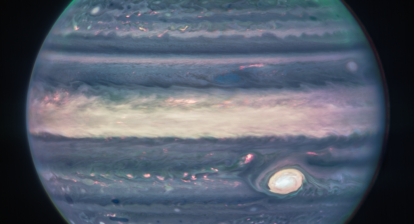Astronomers have found a gigantic galaxy – one that has become the largest known structure in the Universe. It is now known as Alcyoneus and it is a radio galaxy located some 3-billion-light-years away. It reaches 5 megaparsecs into space i.e 16.3 million-light-years long! So, it is clearly extremely huge.
Giant radio galaxies are are types of active galactic nuclei that are very luminous at radio wavelengths. They consist of a host galaxy (almost exclusively large elliptical galaxies), comprising of stars orbiting a supermassive black hole. Giant radio galaxies also have synchroton radiating active galactic nuclei (compact region at the center of a galaxy that has a much-higher-than-normal luminosity over at least some portion of the electromagnetic spectrum with characteristics indicating that the luminosity is not produced by stars) produced by the black hole at the centre, emitting huge jets and lobes. When these jets and lobes interact with space they act as synchrotons, accelerating electrons that give rise to radio emissions. (Smallest Ever Supermassive Black hole Found)
As gas and dust from stars and other objects, orbiting a super massive black hole at the center of a galaxy, falls into it, it forms an accretion disk. This disk emits electromagnetic radiation that can be captured by our instruments. The extreme gravity of the black hole compresses the accretion disk till it reaches millions of degrees kelvin and forms the bright active galactic nucleus (AGN) at the center of a galaxy. (What are black holes?)
Quasars are extremely luminous active galactic nuclei, in which a supermassive black hole with mass ranging from millions to billions of times the mass of the Sun is surrounded by a gaseous accretion disk. The power radiated by quasars is enormous and we are able to detect the electromagnetic radiation they emit with our instruments. Sometimes material from the accretion disk gets redirected from the centre to the poles where it is blasted out to space. Known as a blazar, this is an active galactic nucleus emitting jets composed of ionized matter, traveling nearly at the speed of light.

AGN of Alcyoneus. Source (Oei et al., arXiv, 2022)
The jets emitted by the AGN travel large distances through space and then end up forming radio emitting lobes. These radio lobes are common in galaxies and even our own, the Milky Way, also has them. However, scientists do not yet understand giant radio galaxies i.e the ones that can get to such immensely gigantic megaparsec sizes. Therefore, this new huge structure can help us to understand giant radio galaxies and how they become so huge.
“Being an extreme example in its class, Alcyoneus could shed light on the main mechanisms that drive radio galaxy growth”, say the authors in their paper
The team looked for these behemouths by using data collected by the LOw Frequency ARray (LOFAR) in Europe. This is a network consisting of about 20,000 radio antennas, distributed in 52 locations across Europe. After reprocessing this data, they Alcyoneus.
“We have discovered what is in projection the largest known structure made by a single galaxy — a GRG with a projected
proper length lp = 4.99 ± 0.04 Mpc. The true proper length is at least lmin = 5.04 ± 0.05 Mpc”, write the authors, concluding, “Alcyoneus therefore represents the most promising radio galaxy yet to probe the warm–hot intergalactic medium”.
And here it is.

The radio lobes of Alcyoneus Credit Oei et al., arXiv, 2022







